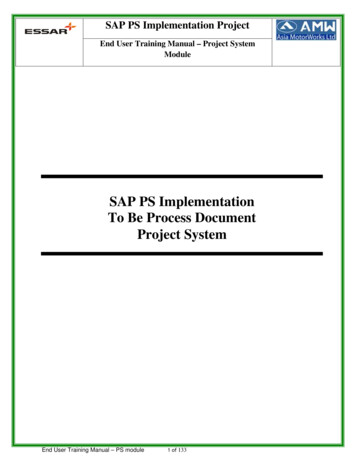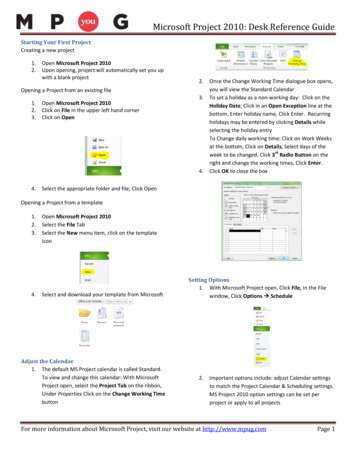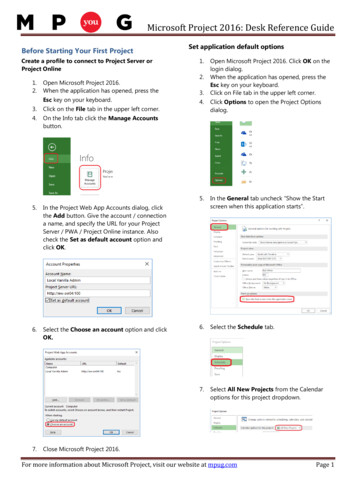
Transcription
Indian Sign Language GestureRecognitionGroup 11CS365 - Project PresentationSanil Jain(12616)Kadi Vinay Sameer Raja(12332)
Indian Sign LanguageHistory ISL uses both hands similar to BritishSign Language and is similar toInternational Sign Language.ISL alphabets derived from British SignLanguage and French Sign Languagealphabets.Unlike its american counterpart whichuses one hand, uses both hands torepresent alphabets.Image Src :http://www.deaftravel.co.uk/signprint.php?id 27
Indian Sign LanguageAmerican Sign LanguageImage Src :http://www.deaftravel.co.uk/signprint.php?id 26Indian Sign LanguageImage Src :http://www.deaftravel.co.uk/signprint.php?id 27
Indian Sign LanguagePrevious Work Gesture Recognitions and Sign Language recognition has been a well researchedtopic for the ASL, but not so for ISL.Few research works have been carried out in Indian Sign Language using imageprocessing/vision techniques.Most of the previous works found either analyzed what features could be better foranalysis or reported results for a subset of the alphabetsChallenges No standard datasets for Indian Sign LanguageUsing two hands leads to occlusion of featuresVariance in sign language with locality and usage of different symbols for the samealphabet by the same person.
Dataset CollectionProblems Lack of standard datasets for Indian Sign LanguageVideos found on internet for the same is of people describing how it looks like andnot those who actually speak itThe one or two datasets we found from previous works were created by a singlemember of the group doing the work.Approach for collection of dataWe went to Jyoti Badhir Vidyalaya, a school for deaf in a remote section of Bithoor.There for each alphabet, we recorded around 60 seconds of video for every alphabetfrom different students.Whenever there were multiple conventions for the same alphabet, we asked for themost commonly used static sign for every alphabet.
Dataset CollectionA recollection of our time at the schoolP.S. also a proof that we actually went there
LearningFrame ExtractionSkin SegmentationFeature ExtractionTraining and Testing
Skin SegmentationInitial Approaches Training on skin segmentation datasetTried machine learning models like SVM, random forests on the skin segmentationdataset fromhttps://archive.ics.uci.edu/ml/datasets/Skin SegmentationVery bad dataset, after training on around 2,00,000 points, skin segmentation ofhand images gave back almost black image(i.e. almost no skin detection) HSV model and constraints on values of H and SConvert Image from RGB to HSV model and retain pixels satisfying 25 H 230 and25 S 230This implementation wasn’t much effective and the authors in the report had usedit along with motion segmentation which made their segmentation slightly better.
Skin SegmentationFinal ApproachIn this approach, we transform the image from RGB space to YIQ and YUV space. FromU and V, we get theta tan-1(V/U). In the original approach, the author classified skinpixels as those with 30 I 100 and 105o theta 150o .Since those parameters weren’t working that good for us, we somewhat tweaked theparameters and it performed much better than the previous two approaches.
Skin SegmentationFinal ApproachIn this approach, we transform the image from RGB space to YIQ and YUV space. FromU and V, we get theta tan-1(V/U). In the original approach, the author classified skinpixels as those with 30 I 100 and 105o theta 150o .Since those parameters weren’t working that good for us, we somewhat tweaked theparameters and it performed much better than the previous two approaches.
Bag of Visual WordsBag of Words approachIn BoW approach for textclassification,a document isrepresented as a bag(multiset) ofits words.In Bag of Visual Words ,we use theBoW approach for imageclassification, whereby every imageis treated as a document.So now “words” need to be definedfor the image also.
Bag of Visual WordsEach image abstracted by several local patches.These patches described by numerical vectors called feature descriptors.One of the most commonly used feature detector and descriptor is SIFT(Scale InverseFeature Transformation) which gives a 128 dimensional vector for every patch.The number of patches can be different for different images.Image Src :http://mi.eng.cam.ac.uk/ cipolla/lectures/PartIB/old/IB-visualcodebook.pdf
Bag of Visual WordsNow we convert these vector represented patches to codewords which produces acodebook(analogous to dictionary of words in text).The approach we use now is Kmeans clustering over all the obtained vectors and get Kcodewords(clusters). Each patch(vector) in image will be mapped to the nearestcluster. Thus similar patches are represented as the same codeword.Image Src :http://mi.eng.cam.ac.uk/ cipolla/lectures/PartIB/old/IB-visualcodebook.pdf
Bag of Visual WordsSo now for every image, the extracted patchvectors are mapped to the nearest codeword, andthe whole image is now represented as a histogramof the codewords.In this histogram, the bins are the codewords andeach bin counts the number of words assigned tothe codeword.Image Src :http://mi.eng.cam.ac.uk/ cipolla/lectures/PartIB/old/IB-visualcodebook.pdf
Bag of Visual WordsImage Src :http://mi.eng.cam.ac.uk/ cipolla/lectures/PartIB/old/IB-visualcodebook.pdf
Results Obtained for Bag of Visual WordsWe took 25 images per alphabet from 3 person each for training and 25 imagesper alphabet from another person for testing.So training over 1950 images, we tested for 650 images and obtained thefollowing results :-Train Set SizeTest Set SizeCorrectly ClassifiedAccuracy195065022033.84%
Results Obtained for Bag of Visual WordsObservations Similar looking alphabets misclassified amongst each otherOne of the persons among the 3 persons was left handed and gave laterallyinverted images for many alphabets.
Future WorkObtain HOG(Histogram of Oriented Gradient) features from scaled down imagesand use Gaussian random projection on them to get feature vectors in a lowerdimensional space. Then use the feature vectors for learning and classification.Apply the models in a hierarchical manner e.g :- classify them as one and twohanded alphabets and then do further classification.
References1.http://mi.eng.cam.ac.uk/ ipedia.org/wiki/Bag-of-words model in computer vision7.Neha V. Tavari, P. A. V. D.,Indian sign language recognition based onhistograms of oriented gradient,International Journal of Computer Scienceand Information Technologies 5, 3 (2014), 3657-3660
Indian Sign Language Previous Work Gesture Recognitions and Sign Language recognition has been a well researched topic for the ASL, but not so for ISL. Few research works have been carried out in Indian Sign Language using image processing/vision techniques. Most of the previous work










